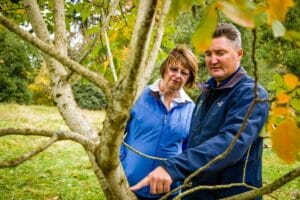 Urban Forest Pro’s arborist, Jeff M, was recently on KOIN 6 news as an expert on Portland tree care. Jeff discussed the implications that the change in weather has for Portland trees. He also advised what to do if your tree has V-shaped splits. In this blog we review Jeff’s advice, focusing on what you can do to get your trees ready for stormy winter weather.
Urban Forest Pro’s arborist, Jeff M, was recently on KOIN 6 news as an expert on Portland tree care. Jeff discussed the implications that the change in weather has for Portland trees. He also advised what to do if your tree has V-shaped splits. In this blog we review Jeff’s advice, focusing on what you can do to get your trees ready for stormy winter weather.
This past summer was certainly dry and hot. Now that the first fall rains have arrived, it is time to list what needs to be done before winter comes. One big task is to conduct Portland tree pruning, keeping a special eye for signs of impending limb drop. Trees that have large, V-shaped splits are in danger of losing one or more structural limbs, as more and more weight is put on the V-shaped split. Excessive rain and snow, high winds, and extremely dry-weather can put additional stress on the tree, and on the upper limbs in particular.
In addition to concentrating on what we can do to address problems that come from large V-splits, Jeff also directed viewers to examine the ground for evidence of fungus, or mushrooms, which could be a sign of tree rot. The dry summer stressed many trees, making them weaker than they typically are in autumn. This is evidenced by the fallen Linden that Jeff and his hosts from KOIN 6 inspected. The Linden had been improperly planted and this left it susceptible to a girdled root, where one root had been left to wrap around the others. This put additional strain on the base of the tree, such that it was not able to handle given the dry conditions of the summer.
Since it has extremely dry this summer, and nasty weather is certainly on its way, it makes sense to take extra time now to inspect trees. Doing so can ensure that there are no problems later. Begin your inspection at the top of the tree. Note if the tree has been topped (i.e., the top has been cut off), if branches overlap, and if certain branches seem to be too heavy. All of these are signs that professional Portland tree trimming is required. Notice the presence of dead wood, indicated by cracking and a brown color throughout the branch. Be cautious following stormy weather, as branches may have been weakened and ready to fall.
Moving down the tree, look for indications of insects and disease. Again, the presence of fungus or mushrooms may indicate rot. If you notice rotten wood, or if there are cavities, it is wise to have the tree inspected by Portland certified arborists from a tree service company such as Urban Forest Pros. A certified arborist can perform specialized tests to evaluate rot. For instance, he or she may drill a small hole into the tree to calculate resistance. This reveals the rate of rot, and denotes the likelihood of falling limbs.
When you consider that mature, healthy trees can add up to 10% to the value of your home, it makes sense to hire a tree care professional that you can trust. An arborist can determine if a tree may be saved, or if it needs to be removed. Urban Forest Pro’s arborists take care with their work, and they will only remove a mature tree if it is absolutely needed. Beware those who advocate removal without looking at other possibilities. Arborists can also stabilize split trunks with the use of fiber cables. Cabling cannot repair damage, but it can reduce the possibility of more damage in the future. Finally, your arborist can conduct pruning, diagnose problems, and suggest earth-friendly ways to combat insects and disease.
If you see evidence of tree damage, have concerns about large V-splits, or have observed any of the signs of rot mentioned above, don’t hesitate to call UFP today. We can help diagnose your problem and recommend the best course of action before brutish winter weather arrives.
This post first appeared on https://www.urbanforestprofessionals.com